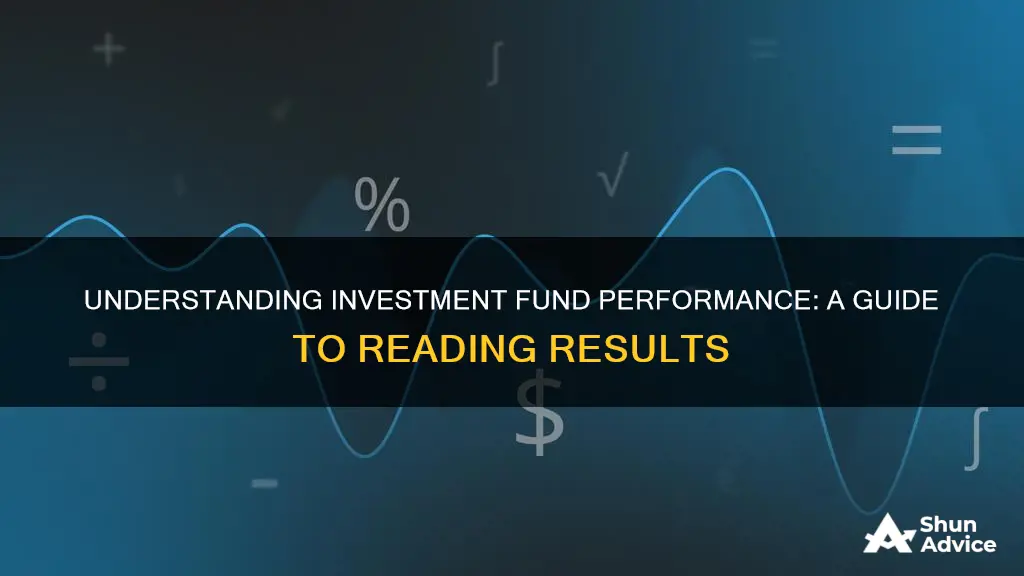
Reading and understanding investment fund performance is a critical part of managing and monitoring your assets. While past performance is not a guarantee of future results, knowing how to analyse fund performance can help you make better investment decisions. There are several factors to consider when evaluating investment fund performance, including investment style, historical performance, fees and expenses, and the track record of the fund manager. It's also important to compare the fund's performance to appropriate benchmarks and peer funds, while also considering market and economic cycles. Additionally, investors should pay attention to risk-adjusted returns, the quality of stocks in the portfolio, and the fund's earnings over time, which can be visualised through performance charts.
| Characteristics | Values |
|---|---|
| Investment style | Growth or value, large or small companies, passive or active investing |
| Risk | Compare with peers to determine if the fund assumes greater risk than average |
| Returns | Check consistency over time and compare with peers |
| Fees | Tactical funds with heavy trading or active management have higher annual expenses |
| Yield | Income generated by investment, usually expressed as a percentage |
| Rate of return | Total money made or lost on an investment |
| Attribution analysis | Top-down or bottom-up approach to stock-picking |
| Performance measures | Transaction fees, taxes, inflation, and rebalancing |
| Benchmarking | Compare hedge fund performance to most relevant asset class, such as fixed income, commodities, or equities |
| Diversification | Alternative investment funds may invest in stocks, shares, fixed income, commodities, or equities |
| Investor preferences | Steady, low-risk gains over the long term |
What You'll Learn

Yield and rate of return
Yield refers to the income generated by an investment, separate from the principal amount. It is often expressed as a percentage, based on either the investment's market value or purchase price. For instance, if you buy a bond with a face value of $1,000 that pays a semiannual coupon of $10, over one year, the bond yields $20, or 2%. This is known as the cost yield. However, if you purchase the same bond on the secondary market for $900, the $20 coupon payments would be a yield of 2.2%, based on the current price, which is known as the current yield.
Yield is also commonly used when discussing dividend stocks. For example, if you buy 100 shares of a company for $5,000 and the company pays a dividend of 50 cents per share each quarter, you would receive $200 in dividend income over a year, a yield of 4%.
The rate of return, on the other hand, is the total gain or loss from an investment, including both income and changes in its price. It is typically expressed as the change in the dollar value of an investment over time. For example, if you bought a stock for $50 and sold it for $60, the return would be $10. If the company also paid a dividend of $1 during the time you held the stock, the total return would be $11, including the capital gain and dividend.
The rate of return can be calculated using the following formula:
Change in value + Income) / Investment amount = Percent return
In the above example, the $500 increase in value plus the $120 in dividends, divided by the original investment of $2,000, would give a percent return of 31%.
Yield is forward-looking and focuses on regular payments like interest or dividends, whereas the rate of return is backward-looking and includes capital gains or depreciation. Yield is typically used by those focused on income generation, while the rate of return is used by those assessing overall investment performance.
Both yield and rate of return are important measurements that can be used together to evaluate an investment's performance and income potential.
Fidelity Roth: Index Funds and Auto-Investing Strategies
You may want to see also

Investment advisers and portfolio managers
Understanding Performance History
When assessing a mutual fund's performance, it's essential to analyse its past returns relative to appropriate benchmarks. Compare the fund's returns to the average returns of similar funds in the same category. Additionally, consider using indices as benchmarks; for instance, comparing a large-cap stock fund to the S&P 500. While past performance doesn't guarantee future outcomes, understanding historical data can help make better investment choices.
Time Periods for Analysis
It's generally recommended to focus on longer time periods, such as 5- and 10-year intervals, for mutual fund performance evaluation. This is because shorter periods, like one year, may not provide sufficient insight into the fund's overall trajectory. However, don't ignore short-term returns entirely, as they can sometimes be warning signals. For instance, an exceptionally high one-year return compared to peers could indicate abnormal performance that may not be sustainable.
Market and Economic Cycles
Consider the impact of market and economic cycles on fund performance. Different fund managers may excel in specific economic conditions. Therefore, evaluating performance across varying economic environments, including recessionary and growth periods, can provide valuable insights. Most economic cycles span five to seven years, so this timeframe is often sufficient to capture different market conditions.
Weighing Performance Periods
When comparing mutual funds, assign heavier weights to the most relevant performance periods. For instance, you might give a 40% weight to the five-year period, 30% to the ten-year period, 20% to the three-year period, and 10% to the one-year period. This approach ensures that more emphasis is placed on periods that offer stronger indications of future performance.
Manager Tenure and Track Record
Always consider the fund manager's tenure when evaluating fund performance. A strong five-year return, for example, is less meaningful if the manager has only been onboard for a year. Additionally, assess the manager's past performance and track record to gauge their competence and the value they bring to the fund.
Evaluating Risk and Returns
Risk-adjusted returns are crucial in understanding the performance of mutual funds. These returns indicate how well a fund has performed relative to the risk undertaken over a specific period. When comparing two funds with the same percentage returns, the one with lower risk will have higher risk-adjusted returns. Benchmarking is also essential, as it allows you to measure the quality of the fund against standard measurements and market competition.
Assessing Peer Performance
Comparing a mutual fund's performance to that of its peers provides valuable insights into relative performance. It's essential to consider the consistency of returns over several years. Select funds that consistently outperform their benchmarks and have demonstrated resilience during market downturns, as this reflects the skills of the fund managers.
Fees and Expenses
Mutual funds come with various fees and expenses, including management fees, operating costs, and marketing expenses. These fees impact the real rate of return, so it's crucial to factor them into your evaluation. Compare the fees of different funds to ensure you're making an informed choice. The expense ratio, stated as an annual percentage of total assets, is a critical factor to consider.
Venture Capital Funds: Smart Investment for Future Growth
You may want to see also

Liquidity, index tracking, and tax shelter
Liquidity, or the ease with which an investment can be converted into cash, is an important consideration when evaluating the performance of an investment fund. Large differences between the liquidity of investment funds' assets and liabilities (i.e. liquidity mismatches) can create vulnerabilities in the financial system and expose funds to a risk of large outflows and sudden drops in market liquidity. Therefore, it is crucial for fund managers to effectively manage liquidity to enhance financial stability and increase the resilience of investment funds. This can be achieved through various tools such as holding a higher percentage of liquid assets, implementing cash buffers, and swing pricing.
Index funds are a type of mutual or exchange-traded fund (ETF) that tracks the performance of a market index, such as the S&P 500, by holding the same stocks or bonds or a representative sample of them. They are designed to mirror the performance of a specific index, offering broad market exposure and diversification across various sectors and asset classes. Index funds have become increasingly popular due to their low costs, passive investing strategy, and strong historical performance relative to actively managed funds.
When considering the performance of an investment fund, it is also important to evaluate the impact of taxes. Tax shelters are legal strategies or investment vehicles that individuals, businesses, or organizations can use to minimize or decrease their taxable incomes and, therefore, their tax liabilities. Common examples include employer-sponsored 401(k) retirement plans, certain insurance products, partnerships, municipal bonds, and real estate investments. Tax shelters can help reduce an individual's or corporation's tax burden, either temporarily or permanently, and should be evaluated with the help of a tax advisor to ensure compliance with IRS regulations.
Overall, liquidity management, index tracking, and tax shelters are important factors to consider when evaluating the performance of an investment fund. By understanding the risks and benefits associated with each of these areas, investors can make more informed decisions about their investment choices and better manage their portfolios.
Mutual Fund SIPs: A Guide to Direct Investing
You may want to see also

Performance line graphs
Line graphs are a great way to visualise a stock's performance over time. They show the movement of a stock's price over a specific period. To read a line graph, you trace each point on the line to the corresponding dollar value on the y-axis (vertical axis) and the date on the x-axis (horizontal axis).
Line graphs are simple but lack some information that other types of charts provide, such as the opening, high and low price of a stock for each period. They also do not show price movements between closing prices. For more detailed information, you can use other types of stock charts, such as bar charts, candlestick charts, point and figure charts, and price scaling charts.
When reading a line graph, or any finance graph, it is important to pay attention to the data surrounding the chart. The timeline is usually displayed at the bottom, and the data being tracked is on the left or right side. If you are looking at the money earned over time, you will see dollar figures on the side.
To follow the trends, match the points on the line to the corresponding dollar amounts. If you see a spike, follow the line down to note the date. For example, Microsoft had a sharp spike in October 2018, when its shares were worth approximately $115 per share.
It is also helpful to look at a variety of time frames to get a true sense of a stock's performance. Savvy investors often look at weekly and monthly charts to get a more reliable view of price fluctuations. It is important to pay close attention to recent weeks and months to understand the current market conditions, but it is also crucial to look back over several years to see how a particular stock typically performs.
Additionally, making side-by-side comparisons of competitors can help you see if one stock tends to perform better than others. This allows you to make more informed investing decisions and understand the historical performance of a stock.
Mutual Funds vs Real Estate: Where Should You Invest?
You may want to see also

Expense ratios
When comparing investment funds, it is crucial to consider their expense ratios. While each fund has its own investment strategy and goals, a higher-expense fund should offer compelling advantages over similar funds with lower expense ratios. The impact of a small difference in expense ratios can be significant over multiple years.
Mutual funds that charge a sales load will provide two sets of return results: net asset value (NAV) returns, which are net of expenses but exclude sales charges, and results that include the impact of the sales charge. The effect of the sales load diminishes over longer reporting periods. For example, a 6% sales load will reduce the fund's annual return by only 0.6% over 10 years, compared to a full 6% reduction in the first year.
When evaluating a mutual fund's expenses, it is essential to review its prospectus and web pages, where this information is typically disclosed. Additionally, brokerage platforms often provide mutual fund screeners that allow investors to filter funds based on their investing priorities, such as expense ratios.
By considering the expense ratios and comparing them across different investment funds, investors can make more informed decisions and select funds that align with their financial goals and tolerance for fees and expenses.
A Guide to Investing in Hong Kong Funds
You may want to see also
Frequently asked questions
You can use an online tool such as a mutual fund screener or a performance chart. These allow you to compare the performance of several funds at once, and over the same period of time. You can also compare funds by looking at their fees and expense ratios.
There are several ways to measure performance, including yield, rate of return, and risk-adjusted returns. Yield is expressed as a percentage and measures the income generated by an investment over a specific period. Rate of return is the money made or lost on an investment, and can be calculated as a percentage. Risk-adjusted returns compare the returns of a fund to the risk indicated over a given period of time.
It is recommended to evaluate your investments at least once a year, at roughly the same time each year. This allows you to track the progress of your investment goals and make any necessary adjustments.
In addition to the fund's returns, you should consider the fees and expenses associated with the fund, the fund manager's track record and competence, the quality of stocks in the portfolio, and the fund's performance relative to its peers and appropriate benchmarks.







